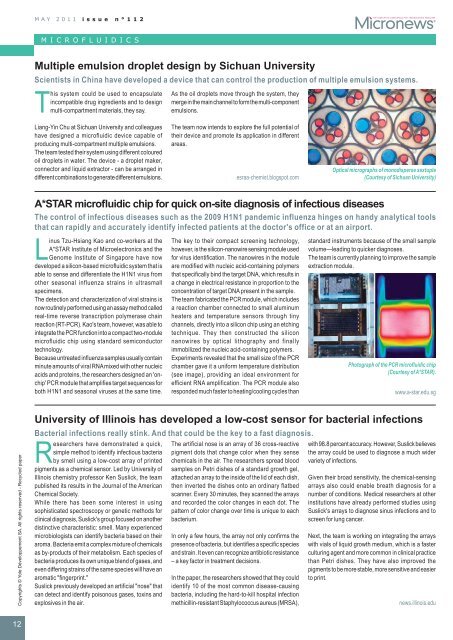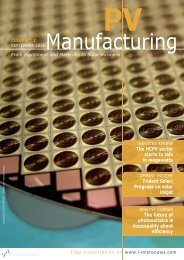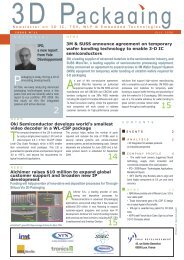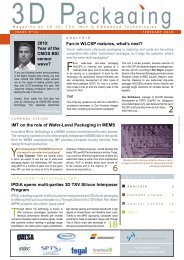Microvision establishes first global R&D center in ... - I-Micronews
Microvision establishes first global R&D center in ... - I-Micronews
Microvision establishes first global R&D center in ... - I-Micronews
You also want an ePaper? Increase the reach of your titles
YUMPU automatically turns print PDFs into web optimized ePapers that Google loves.
MAY 2011 issue n°112<br />
THE DISRUPTIVE SEMICONDUCTOR TECHNOLOGIES MAGAZINE<br />
MICROFLUIDICS<br />
Multiple emulsion droplet design by Sichuan University<br />
Scientists <strong>in</strong> Ch<strong>in</strong>a have developed a device that can control the production of multiple emulsion systems.<br />
This system could be used to encapsulate<br />
<strong>in</strong>compatible drug <strong>in</strong>gredients and to design<br />
multi-compartment materials, they say.<br />
As the oil droplets move through the system, they<br />
merge <strong>in</strong> the ma<strong>in</strong> channel to form the multi-component<br />
emulsions.<br />
Liang-Y<strong>in</strong> Chu at Sichuan University and colleagues<br />
have designed a microfluidic device capable of<br />
produc<strong>in</strong>g multi-compartment multiple emulsions.<br />
The team tested their system us<strong>in</strong>g different coloured<br />
oil droplets <strong>in</strong> water. The device - a droplet maker,<br />
connector and liquid extractor - can be arranged <strong>in</strong><br />
different comb<strong>in</strong>ations to generate different emulsions.<br />
The team now <strong>in</strong>tends to explore the full potential of<br />
their device and promote its application <strong>in</strong> different<br />
areas.<br />
esraa-chemist.blogspot.com<br />
Optical micrographs of monodisperse sextuple<br />
(Courtesy of Sichuan University)<br />
A*STAR microfluidic chip for quick on-site diagnosis of <strong>in</strong>fectious diseases<br />
The control of <strong>in</strong>fectious diseases such as the 2009 H1N1 pandemic <strong>in</strong>fluenza h<strong>in</strong>ges on handy analytical tools<br />
that can rapidly and accurately identify <strong>in</strong>fected patients at the doctor's office or at an airport.<br />
L<strong>in</strong>us Tzu-Hsiang Kao and co-workers at the<br />
A*STAR Institute of Microelectronics and the<br />
Genome Institute of S<strong>in</strong>gapore have now<br />
developed a silicon-based microfluidic system that is<br />
able to sense and differentiate the H1N1 virus from<br />
other seasonal <strong>in</strong>fluenza stra<strong>in</strong>s <strong>in</strong> ultrasmall<br />
specimens.<br />
The detection and characterization of viral stra<strong>in</strong>s is<br />
now rout<strong>in</strong>ely performed us<strong>in</strong>g an assay method called<br />
real-time reverse transcription polymerase cha<strong>in</strong><br />
reaction (RT-PCR). Kao's team, however, was able to<br />
<strong>in</strong>tegrate the PCR function <strong>in</strong>to a compact two-module<br />
microfluidic chip us<strong>in</strong>g standard semiconductor<br />
technology.<br />
Because untreated <strong>in</strong>fluenza samples usually conta<strong>in</strong><br />
m<strong>in</strong>ute amounts of viral RNA mixed with other nucleic<br />
acids and prote<strong>in</strong>s, the researchers designed an 'onchip'<br />
PCR module that amplifies target sequences for<br />
both H1N1 and seasonal viruses at the same time.<br />
The key to their compact screen<strong>in</strong>g technology,<br />
however, is the silicon-nanowire sens<strong>in</strong>g module used<br />
for virus identification. The nanowires <strong>in</strong> the module<br />
are modified with nucleic acid-conta<strong>in</strong><strong>in</strong>g polymers<br />
that specifically b<strong>in</strong>d the target DNA, which results <strong>in</strong><br />
a change <strong>in</strong> electrical resistance <strong>in</strong> proportion to the<br />
concentration of target DNA present <strong>in</strong> the sample.<br />
The team fabricated the PCR module, which <strong>in</strong>cludes<br />
a reaction chamber connected to small alum<strong>in</strong>um<br />
heaters and temperature sensors through t<strong>in</strong>y<br />
channels, directly <strong>in</strong>to a silicon chip us<strong>in</strong>g an etch<strong>in</strong>g<br />
technique. They then constructed the silicon<br />
nanowires by optical lithography and f<strong>in</strong>ally<br />
immobilized the nucleic acid-conta<strong>in</strong><strong>in</strong>g polymers.<br />
Experiments revealed that the small size of the PCR<br />
chamber gave it a uniform temperature distribution<br />
(see image), provid<strong>in</strong>g an ideal environment for<br />
efficient RNA amplification. The PCR module also<br />
responded much faster to heat<strong>in</strong>g/cool<strong>in</strong>g cycles than<br />
standard <strong>in</strong>struments because of the small sample<br />
volume—lead<strong>in</strong>g to quicker diagnoses.<br />
The team is currently plann<strong>in</strong>g to improve the sample<br />
extraction module.<br />
Photograph of the PCR microfluidic chip<br />
(Courtesy of A*STAR).<br />
www.a-star.edu.sg<br />
Copyrights © Yole Développement SA. All rights reserved - Recycled paper<br />
University of Ill<strong>in</strong>ois has developed a low-cost sensor for bacterial <strong>in</strong>fections<br />
Bacterial <strong>in</strong>fections really st<strong>in</strong>k. And that could be the key to a fast diagnosis.<br />
Researchers have demonstrated a quick,<br />
simple method to identify <strong>in</strong>fectious bacteria<br />
by smell us<strong>in</strong>g a low-cost array of pr<strong>in</strong>ted<br />
pigments as a chemical sensor. Led by University of<br />
Ill<strong>in</strong>ois chemistry professor Ken Suslick, the team<br />
published its results <strong>in</strong> the Journal of the American<br />
Chemical Society.<br />
While there has been some <strong>in</strong>terest <strong>in</strong> us<strong>in</strong>g<br />
sophisticated spectroscopy or genetic methods for<br />
cl<strong>in</strong>ical diagnosis, Suslick's group focused on another<br />
dist<strong>in</strong>ctive characteristic: smell. Many experienced<br />
microbiologists can identify bacteria based on their<br />
aroma. Bacteria emit a complex mixture of chemicals<br />
as by-products of their metabolism. Each species of<br />
bacteria produces its own unique blend of gases, and<br />
even differ<strong>in</strong>g stra<strong>in</strong>s of the same species will have an<br />
aromatic "f<strong>in</strong>gerpr<strong>in</strong>t."<br />
Suslick previously developed an artificial "nose" that<br />
can detect and identify poisonous gases, tox<strong>in</strong>s and<br />
explosives <strong>in</strong> the air.<br />
The artificial nose is an array of 36 cross-reactive<br />
pigment dots that change color when they sense<br />
chemicals <strong>in</strong> the air. The researchers spread blood<br />
samples on Petri dishes of a standard growth gel,<br />
attached an array to the <strong>in</strong>side of the lid of each dish,<br />
then <strong>in</strong>verted the dishes onto an ord<strong>in</strong>ary flatbed<br />
scanner. Every 30 m<strong>in</strong>utes, they scanned the arrays<br />
and recorded the color changes <strong>in</strong> each dot. The<br />
pattern of color change over time is unique to each<br />
bacterium.<br />
In only a few hours, the array not only confirms the<br />
presence of bacteria, but identifies a specific species<br />
and stra<strong>in</strong>. It even can recognize antibiotic resistance<br />
– a key factor <strong>in</strong> treatment decisions.<br />
In the paper, the researchers showed that they could<br />
identify 10 of the most common disease-caus<strong>in</strong>g<br />
bacteria, <strong>in</strong>clud<strong>in</strong>g the hard-to-kill hospital <strong>in</strong>fection<br />
methicill<strong>in</strong>-resistant Staphylococcus aureus (MRSA),<br />
with 98.8 percent accuracy. However, Suslick believes<br />
the array could be used to diagnose a much wider<br />
variety of <strong>in</strong>fections.<br />
Given their broad sensitivity, the chemical-sens<strong>in</strong>g<br />
arrays also could enable breath diagnosis for a<br />
number of conditions. Medical researchers at other<br />
<strong>in</strong>stitutions have already performed studies us<strong>in</strong>g<br />
Suslick's arrays to diagnose s<strong>in</strong>us <strong>in</strong>fections and to<br />
screen for lung cancer.<br />
Next, the team is work<strong>in</strong>g on <strong>in</strong>tegrat<strong>in</strong>g the arrays<br />
with vials of liquid growth medium, which is a faster<br />
cultur<strong>in</strong>g agent and more common <strong>in</strong> cl<strong>in</strong>ical practice<br />
than Petri dishes. They have also improved the<br />
pigments to be more stable, more sensitive and easier<br />
to pr<strong>in</strong>t.<br />
news.ill<strong>in</strong>ois.edu<br />
12

















